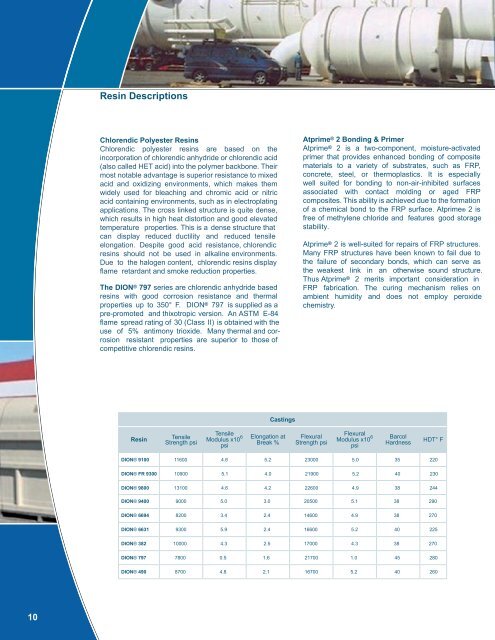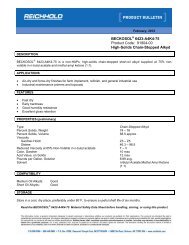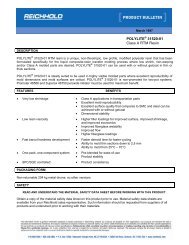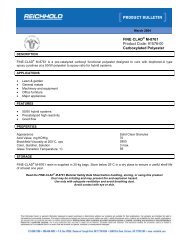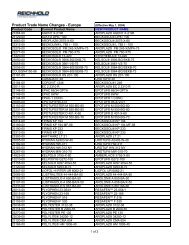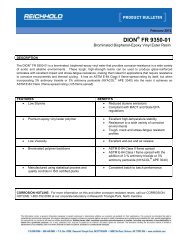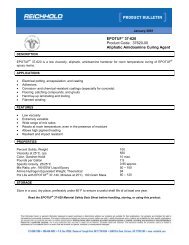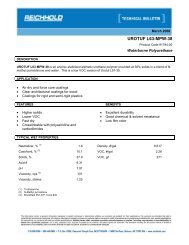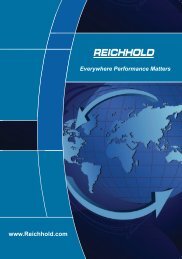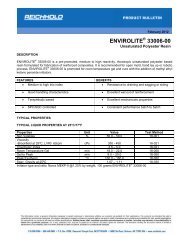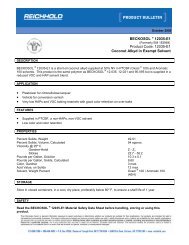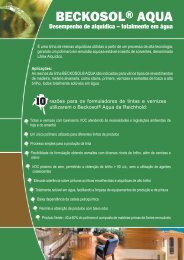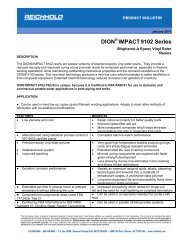CORROSION GUIDE 181108_new table content format ... - Reichhold
CORROSION GUIDE 181108_new table content format ... - Reichhold
CORROSION GUIDE 181108_new table content format ... - Reichhold
Create successful ePaper yourself
Turn your PDF publications into a flip-book with our unique Google optimized e-Paper software.
Resin Descriptions<br />
Chlorendic Polyester Resins<br />
Chlorendic polyester resins are based on the<br />
incorporation of chlorendic anhydride or chlorendic acid<br />
(also called HET acid) into the polymer backbone. Their<br />
most no<strong>table</strong> advantage is superior resistance to mixed<br />
acid and oxidizing environments, which makes them<br />
widely used for bleaching and chromic acid or nitric<br />
acid containing environments, such as in electroplating<br />
applications. The cross linked structure is quite dense,<br />
which results in high heat distortion and good elevated<br />
temperature properties. This is a dense structure that<br />
can display reduced ductility and reduced tensile<br />
elongation. Despite good acid resistance, chlorendic<br />
resins should not be used in alkaline environments.<br />
Due to the halogen <strong>content</strong>, chlorendic resins display<br />
flame retardant and smoke reduction properties.<br />
The DION ® 797 series are chlorendic anhydride based<br />
resins with good corrosion resistance and thermal<br />
properties up to 350° F. DION ® 797 is supplied as a<br />
pre-promoted and thixotropic version. An ASTM E-84<br />
flame spread rating of 30 (Class II) is obtained with the<br />
use of 5% antimony trioxide. Many thermal and corrosion<br />
resistant properties are superior to those of<br />
competitive chlorendic resins.<br />
Atprime ® 2 Bonding & Primer<br />
Atprime ® 2 is a two-component, moisture-activated<br />
primer that provides enhanced bonding of composite<br />
materials to a variety of substrates, such as FRP,<br />
concrete, steel, or thermoplastics. It is especially<br />
well suited for bonding to non-air-inhibited surfaces<br />
associated with contact molding or aged FRP<br />
composites. This ability is achieved due to the <strong>format</strong>ion<br />
of a chemical bond to the FRP surface. Atprime® 2 is<br />
free of methylene chloride and features good storage<br />
stability.<br />
Atprime ® 2 is well-suited for repairs of FRP structures.<br />
Many FRP structures have been known to fail due to<br />
the failure of secondary bonds, which can serve as<br />
the weakest link in an otherwise sound structure.<br />
Thus Atprime ® 2 merits important consideration in<br />
FRP fabrication. The curing mechanism relies on<br />
ambient humidity and does not employ peroxide<br />
chemistry.<br />
Castings<br />
Resin<br />
Tensile<br />
Strength psi<br />
Tensile<br />
Modulus x10 6<br />
psi<br />
Elongation at<br />
Break %<br />
Flexural<br />
Strength psi<br />
Flexural<br />
Modulus x10 6<br />
psi<br />
Barcol<br />
Hardness<br />
HDT° F<br />
DION® 9100 11600 4.6 5.2 23000 5.0 35 220<br />
DION® FR 9300 10900 5.1 4.0 21900 5.2 40 230<br />
DION® 9800 13100 4.6 4.2 22600 4.9 38 244<br />
DION® 9400 9000 5.0 3.0 20500 5.1 38 290<br />
DION® 6694 8200 3.4 2.4 14600 4.9 38 270<br />
DION® 6631 9300 5.9 2.4 16600 5.2 40 225<br />
DION® 382 10000 4.3 2.5 17000 4.3 38 270<br />
DION® 797 7800 0.5 1.6 21700 1.0 45 280<br />
DION® 490 8700 4.8 2.1 16700 5.2 40 260<br />
10


